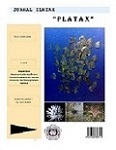Food Habits of Lencam Lethrinu Food Habits of Lencam Lethrinus rubrioperculatus Sato, 1978 (Fish: Lethrinidae)
DOI:
https://doi.org/10.35800/jip.v11i1.43931Abstract
This study was conducted to determine the type and composition of food contained in the stomach of the Spotchheek emperor Lethrinus rubrioperculatus in Napo Keluar Nain Likupang waters based on sex and body size. Samples were taken from the catch of fishermen and then the fish samples were then taken to the laboratory for data collection. The method used to determine the composition of fish food used the Index of preponderance (IP). The results showed that the food habits of Spotchheek emperor in Napo Luar Nain Likupang waters with the types of food contained in the stomach of Spotchheek emperor, namely fish, shrimp, gastropods, Polychaeta, crabs (megalopa), and octopus where the main food of Spotchheek emperor is IP fish (94,16%). While the main food based on sex and length of body size is fish, with male IP 96.98% and female 91.15% respectively, while based on body length of Spotchheek emperor where small IP 91.06%, medium IP 98.45% and large IP 82.22%.
Keywords: Food, Likupang, preponderance
Abstrak
Penelitian ini dilakukan untuk mengetahui jenis dan komposisi makanan yang terdapat dalam lambung ikan lencam Lethrinus rubrioperculatus di Napo Keluar Nain Perairan Likupang berdasarkan jenis kelamin dan ukuran tubuh. Sampel diambil dari hasil tangkapan nelayan kemudian sampel ikan selanjutnya dibawah ke Labolatorium untuk pengambilan data. Metode yang digunakan untuk mengetahui komposisi makanan ikan digunakan indeks bagian terbesar (IBT). Metode ini digunakan untuk menilai bermacam-macam jenis makanan ikan.
Hasil penelitian menunjukan bahwa kebiasaan makanan ikan lencam di Napo Keluar Nain Perairan Likupang dengan jenis makanan yang terdapat dalam lambung ikan lencam yaitu ikan, udang, gastropoda, polychaeta, kepiting (megalopa) dan octopus di mana makanan utama dari ikan lencam adalah ikan IBT (94,16%). Sedangkan makanan utama berdasarkan jenis kelamin dan panjang ukuran tubuh yaitu ikan, dengan masing-masing IBT jantan 96,07% dan betina 91,15% sedangkan berdasarkan panjang ukuran tubuh ikan lencam IBT kecil 91,98%, sedang 98,45% dan besar 82,22%.
Kata kunci: Makanan, Likupang, Indeks Bagian Terbesar.
References
Carpenter, K. E. & G. R. Allen, (1989). FAO Species Catalogue. Vol. 9. Emperor fishes and large-eye breams of the world (Family Lethrinidae). An annotated and illustrated catalogue of lethrinid species known to date. FAO Fish. Synop. 125(9):118 p.
Effendie, M. I. (2002). Biologi Perikanan. Yayasan Pustaka Nusatama, Yogyakarta. 161 Hal.
Effendie. M. I., (1979), Metode Biologi Perikanan. Institut Pertanian Bogor. 112 Hal.
Gerking S. D. (1994). Feeding Ecology of Fish. Academic Press. San Diego.
Jenning. (2003). Marine Fisheries Ecology. Centre For Environment, Fisheries and Agriculture Science. Hongkong.
Lagler, K.F., J. E. Bardach, R. R. Miller, D. R. M. Passino (1977). Ichthyology, Second Edition. John Wiley & Sons, Inc New York. 506 p.
Mudjiman, A. (1989). Makanan Ikan. Penebar Swadaya. Jakarta.
Prihardhani, D. I. & Yunianta. (2016). Ekstraksi gelatin kulit ikan lencam (Lethrinus sp) dan aplikasinya untuk produk permen jeli. J. Pangan dan Agroindustry 4(1): 356-366.
Simanjuntak, C.P.H & A. Zahid. (2009). Kebiasaan makanan dan perubahan ontogenetik makanan ikan baji-baji (Grammoplites scaber) di Pantai Mayangan, Jawa Barat. J. Iktiologi Indonesia. 9 (1): 63-73
Sturges H, (1926). The choice of a Class Interval, Journal of the American Statistical Association,21,(153):65-66
Tampi, A. A. (2021). Anatomi Dan Biometri Sistem Pencernaan Ikan Lencam Lethrinus rubrioperculatus Sato, 1978. Laporan praktek kerja lapang Program Studi Manajemen Sumberdaya Perairan Fakultas Perikanan dan Ilmu Kelautan UNSRAT.
Trianni, M. S., & M. C. Tenorio ( 2012). Gross Diet Composition and Trophic Level Estimation of the Spotcheek Emperor, Lethrinus rubrioperculatus (Actinopterygii: Perciformes: Lethrinidae), in the Commonwealth of the Northern Mariana Islands, Micronesia. Acta Ichthyologica Et Piscatoria, 42(2): 89-99
Downloads
Published
How to Cite
Issue
Section
License
Copyright (c) 2022 Aprillia Anggie Tampi, Nego E. Bataragoa, Jety K. Rangan, Unstain N. W. J. Rembet, Stephanus V. Mandagi, Farnis B. Boneka

This work is licensed under a Creative Commons Attribution-NonCommercial 4.0 International License.
COPYRIGHT
Authors who publish with this journal agree to the following terms:
Authors hold their copyright and grant this journal the privilege of first publication, with the work simultaneously licensed under a Creative Commons Attribution License that permits others to impart the work with an acknowledgment of the work's origin and initial publication by this journal.
Authors can enter into separate or additional contractual arrangements for the non-exclusive distribution of the journal's published version of the work (for example, post it to an institutional repository or publish it in a book), with an acknowledgment of its underlying publication in this journal.
Authors are permitted and encouraged to post their work online (for example, in institutional repositories or on their website) as it can lead to productive exchanges, as well as earlier and greater citation of the published work (See The Effect of Open Access).






































